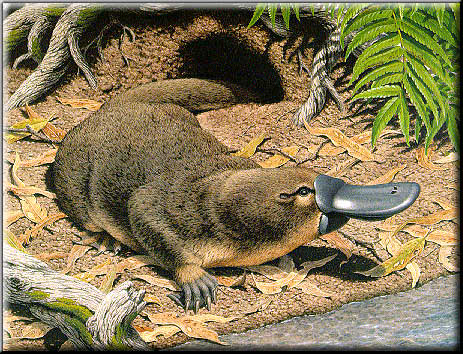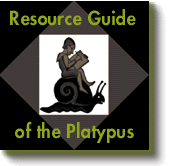


Platypus by Rod Scott  SPECIAL FEATURE: Article on the Platypus from the Penny Magazine, England, 1835.
SPECIAL FEATURE: Article on the Platypus from the Penny Magazine, England, 1835.
|
|
platypus [mod.L. (Shaw 1799), Gr. platypous flat-footed platys flat + pous foot. Originally the generic name, but, having already been given to a genus of beetles, it was in 1800 changed for Ornithorhynchus.] A small, aquatic, egg-laying monotreme mammal (Ornithorhynchus anatinus, with webbed feet, a tail like a beaver's, and a horny beak resembling the bill of a duck: in full duckbill platypus. It inhabits rivers and their banks in eastern Australia and Tasmania. A name of the ornithorhynchus or duck-mole of Australia, the sole representative of the family Ornithorhynchidae. 1799 Shaw Naturalist's Misc. X. Pl. 385 Explan., The Duckbilled Platypus. 1832 J. Bischoff Van Diemen's Land iii. 52 The skins of the_oppossum, tiger-cat, and platthypus, or ornythorhyncus paradoxus, are exported. 1860 G. Bennett Gatherings Nat. Australasia vi. 135 Besides combing their fur to clean it when wet, I have seen them preen it with their beak (if the term may be allowed) as a duck would clean its feathers. 1878 R. B. Smyth Aborigines of Victoria I. 251 The duck-billed platypus makes no nests, but lives in holes on the banks of rivers. 1893 Scribner's Mag. June 792/2 Platypus hunting requires as quick an eye and hand as shooting woodcock in close cover. Ibid. 794/1 Platypus shopping-bags and purses are not disdained by the fair who crowd the marts in Melbourne, or in Sydney. 1904-06 Beach, F.C., Rines, G.E. Mammals. In: The Americana, A Universal Reference Library, vol. 9. New York: Scientific American. ...but many mammals which do not possess teeth when adults, have rudimentary teeth in the foetal stages. Such is the case with the whalebone whale, and with the platypus. The rudimentary teeth in these disappear early and are replaced by whalebone and horney plates, respectively. monotremata pl. [mod.L., neut. pl. of monotrematus adj., f. Gr. meno-v (mono-) + trhmat-, tr#ma perforation, hole, f. tr!- root of the tetraanein to bore through, perforate] The lowest Order of Mammalia, containing mammals which have only one opening or vent for the genital, urinary, and digestive organs. The Order comprises the duck-billed platypus (Ornithorhynchus paradoxus) and several species of spiny ant-eaters of the genera Tachyglossus (or Echidna) and Zaglossus or Acanthoglossus. They are native to Australia and New Guinea, and are oviparous. 1822-34 Good Study Med. (ed. 4) III. 13 The platypus or ornithorhynchus as he [Blumenbach] calls it, that most extraordinary duck-billed quadruped which has lately been discovered in Australasia. 1833 Proc. Zool. Soc. 12 Mar. 29 [tr. of Geoffroy St. Hilaire], The Monotremata. 1835-36 Todd's Cycl. Anat. I. 174/2 The monotrematous animals_form a complete exception to this statement. 1839-47 Owen in Todd's Cycl. Anat. III. 368/1 The skull in both genera of Monotremata is long and depressed. 1847 Carpenter Zool. _317 The Ornithorhyncus or Duck-billed Platypus, the Water Mole of the Colonist. 1859 Cornwallis New World I. 35 Know ye the land contrariety sways_Where black swans_With water-rats, duck-billed, come forth to the day? 1884 Rep. Brit. Assoc. 777 Mr. Caldwell_had discovered that the Monotremes were oviparous. ornithorhynchus [mod. f. ornitho- + bill.] An aquatic mammal of Australia, the duck-billed platypus or duck-mole (O. paradoxus or anatinus), the only species of its genus and family in the order Monotremata; it has glossy dark-brown fur, webbed feet and bill like a duck's; it lays eggs like a bird. 1800 Phil. Trans. XC. 432 My opportunities of examining the Ornithorhynchus were procured through Sir Joseph Banks. A shortening of the specific name paradoxus of the Platypus (Ornithorhynchus paradoxus). 1815 in O'Hara Hist. N.S.W. (1817) 452 The water-mole, or paradox, also abounds in all the rivers and ponds. 1820 J. Oxley Jrnl. 2 Exp. N.S. Wales 284 We saw numbers of the ornithorynchus, or water mole, in the river. 1864 Owen Power of God 46 The anomalous Ornithorhynchus, with the tail of a beaver, the skin of a mole, the beak of a duck, and the spurs of a cock. 1870 Courthope Paradise of Birds 70 For he gave to the Earth the first animal birth, and conceived the Ornithorhyncus. 1892 J. A. Thomson Outlines Zool. 566 The mammary glands in the female Ornithorhynchus open on a flat patch. platypod a. and n. [f. Gr. flat-footed.] a. adj. Having broad or flat feet; spec. belonging to the group Platypoda of monotrematous mammals (typical genus Platypus), or to the group Platypoda of gastropod molluscs, having a broad flat foot adapted for crawling; also in Orinth. having the toes joined so as to form a broad sole, syndactyl. b. n. A broad-footed animal; one belonging to any of these groups. 1846 Smart Suppl., Platypod, a broad-footed animal. tambreet [Mallangong lang. of New South Wales.] A native name of the duckbilled platypus. 1840 Penny Cycl. XVII. 28/1 The Duckbill, or Duckbilled Platypus; Mallangong, Tambreet, Water-mole of the English colonists. platypussary Austral. Also platypusary, platypussery. [f. platypus + -ary.] An enclosure or building in which platypuses are kept. 1945 Baker Austral. Lang. xiv. 242 Platypussary has made its appearance only in recent years. 1960 — Drum 135 Platypussery: A pen or specially prepared area in which platypuses are kept. Also, platypussary. 1966 G. Durrell Two in Bush v. 161 David's pair were housed in his specially designed Platypusary. Reading ListBarrett, Charles Leslie. (1944). The world's wonder animal, the platypus ... Melbourne, Robertson. 62 p. Burrell, Harry James. (1927). The platypus, its discovery, zoological position, form and characteristics, habits, life history, etc. with 35 plates. Sydney, Angus & Robertson limited. 227p. Eadie, Robert. (c1935). The life and habits of the platypus. With sidelights on "Splash" the tame platypus. Illustrated with photographs by Morwell Hodges; with a foreword by Harold W. Clapp. 1st ed. Melbourne : Stillwell & Stephens, 78p. Fleay, David Howells. (1944). We breed the platypus. (2d ed.). Melbourne, Robertson & Mullens. 44p. Gould, Stephen Jay. (1985). To be a platypus. Natural History, 94(8): 10-15. On various descriptions of and theories concerning the platypus through history. Grant, T.Q., and Dawson, T.J. (1978). Temperature regulation in the platypus Ornithorynchus anatinus: Production and loss of metabloic heat in air and water: Physiological Zoology, v. 51, pp. 315-332. Grant, Tom. (1984). The platypus.; illustrations by Dominic Fanning. Kensington, NSW, Australia: New South Wales University Press. 76p. Grant, Tom. (1989). The platypus: a unique mammal; illustrated by Dominic Fanning. (Rev. ed.) Kensington, NSW, Australia : New South Wales University Press. 73p. Grant, Tom. (1995). The platypus: a unique mammal.; illustrations by Dominic Fanning. Rev. ed. Sydney, Australia: University of New South Wales Press. 92p. Heckner, Ursula. (1990). Egg-laying mammals (monotremes). In: Grzimek's Encyclopedia, Mammals Vol.1. New York: McGraw-Hill Publishing Company, pp. 190-207. Platypus and echidnas. (1992). Ed. Michael L. Augee. Mosman, NSW, Australia: Royal Zoological Society of New South Wales. 296p. |
|
Tasmanian Sightings
Mail To: Comments, Additions, and Suggestions
This site is sponsored by Platypus Computing. |